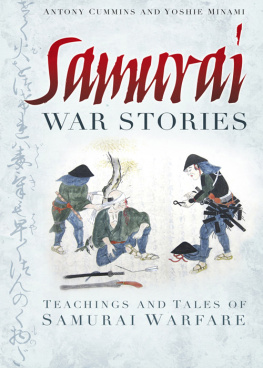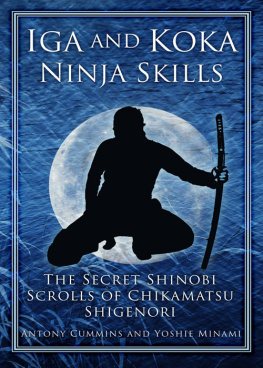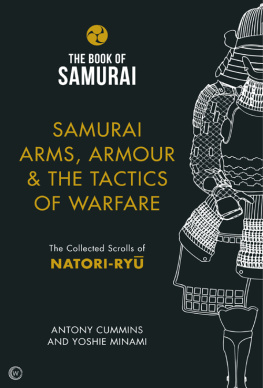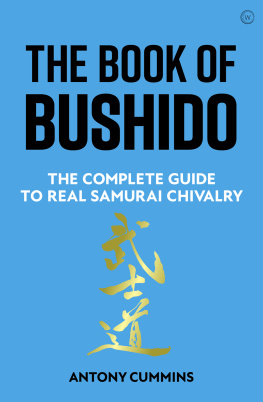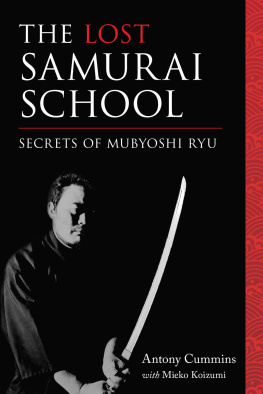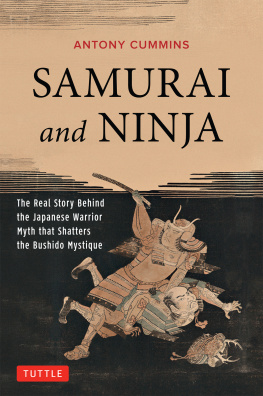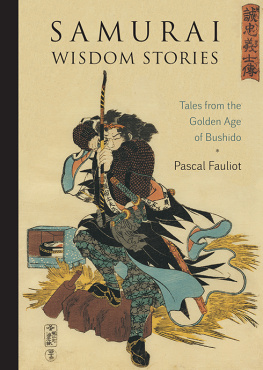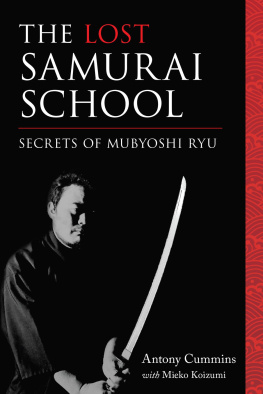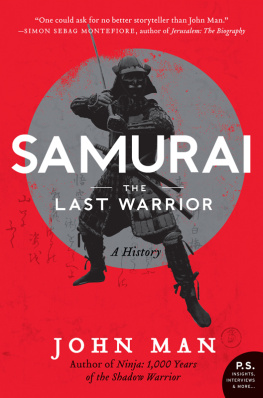Cummins Antony - Samurai war stories teachings and tales of Samurai warfare
Here you can read online Cummins Antony - Samurai war stories teachings and tales of Samurai warfare full text of the book (entire story) in english for free. Download pdf and epub, get meaning, cover and reviews about this ebook. City: Stroud;England, year: 2013, publisher: The History Press, genre: History. Description of the work, (preface) as well as reviews are available. Best literature library LitArk.com created for fans of good reading and offers a wide selection of genres:
Romance novel
Science fiction
Adventure
Detective
Science
History
Home and family
Prose
Art
Politics
Computer
Non-fiction
Religion
Business
Children
Humor
Choose a favorite category and find really read worthwhile books. Enjoy immersion in the world of imagination, feel the emotions of the characters or learn something new for yourself, make an fascinating discovery.
- Book:Samurai war stories teachings and tales of Samurai warfare
- Author:
- Publisher:The History Press
- Genre:
- Year:2013
- City:Stroud;England
- Rating:5 / 5
- Favourites:Add to favourites
- Your mark:
- 100
- 1
- 2
- 3
- 4
- 5
Samurai war stories teachings and tales of Samurai warfare: summary, description and annotation
We offer to read an annotation, description, summary or preface (depends on what the author of the book "Samurai war stories teachings and tales of Samurai warfare" wrote himself). If you haven't found the necessary information about the book — write in the comments, we will try to find it.
Samurai war stories teachings and tales of Samurai warfare — read online for free the complete book (whole text) full work
Below is the text of the book, divided by pages. System saving the place of the last page read, allows you to conveniently read the book "Samurai war stories teachings and tales of Samurai warfare" online for free, without having to search again every time where you left off. Put a bookmark, and you can go to the page where you finished reading at any time.
Font size:
Interval:
Bookmark:
For Crystal, Austin and Claire siblings who have endured my interests for many years
A special thank you to Jackie Sheffield for her proofreading and preliminary editing, and also to Shaun Barrington, my editor at The History Press, for his continued support in helping to bring this and many other translations to life.
H istory as I will repeat many times in my career is best told by the people who were there. The samurai, while extraordinarily popular, are dramatically misunderstood. That is, people know what the samurai are, they know what they look like and they even have an ingrained presupposition of how they should act. However, this samurai image which is one of Japans biggest cultural exports is a soft image of the reality of the medieval world of Japan. Todays image is terribly oversimplified. This work will by no means correct this problem in its entirety, but will be more of a first step in revealing the real lives of the medieval knights of Japan. Embedded in a complex hierarchy and further subdivided by skills and tasks, an understanding of the whole of samurai culture takes an academics devotion to understand. Therefore, to start to describe such a complex pattern, this text will separate out and display three main areas of the warrior culture of Japan. The first are the samurai themselves; the group of landed gentry eerily similar to landed European knights who are given fiefs so that they can provide war horses, gear, men and service in the name of their lords. The second is the ashigaru, or Japanese foot soldiers, a group who have all but been brushed out of history. These lower class men were either conscripted, mercenary, or owed military service to a ruling family. A form of militia that were brought together for basic training and campaign duties, they make up the bulk of samurai armies and even venture into fully paid professional soldiering in some periods of history. Lastly, we consider the females of the samurai class, as seldom has there been an investigation into the position of the female in war. Three major Japanese texts have been brought together here to highlight these aspects of samurai culture and each will, it is hoped, help to develop a finer picture of a very exotic and mysterious world.
To understand medieval warfare is to begin to understand samurai culture. It is a preconceived perception that samurai combat is an honourable affair, with proud men on chargers calling out their family names and rank. However, this idealistic and simplistic understanding comes from great war chronicles, such as the Taiheiki text, which highlight the prowess of brave knights who have charged to their death. While this behaviour does indeed exist within the samurai class, it is only a small part of samurai warfare. In fact, betrayal, teamwork, hit-and-run, tactical withdrawal, assassination and all the facets of total war are found. Therefore, here you will read of the war deeds of both brave and cowardly samurai; read who beheaded whom; and learn all the skills needed to be an ashigaru foot soldier, or even how to decorate the heads of the dead if you happen to have the misfortune of being a female blockaded inside a castle.
Overall, this text is a foretaste of future translated volumes dedicated to the exploration of samurai warfare and the violent world in which they lived. Therefore, ignite the engine of the imagination and colour all of the mud, blood, smoke and flying banners that can be found among the black and white of this book.
Antony Cummins
Warabi
Japan
Historical Manuscripts
Translated
With a possible three authors, this selection of tales is written from the perspective of the lower-ranking soldiers and servants of the samurai which is reflected in the syntax and tone. The purpose of this text was to teach lower-ranking soldiers the dos and donts of Japanese warfare through a collection of semi-fictional and semi-comical anecdotes attributed to imaginary warriors, and to deal with the very real needs of the battlefield.
The document can be dated and placed between two events, pointing to its origin somewhere between 1657 and 1684. In 1657 a devastating fire broke out in Edo called the Meireki-no-Taika, a disaster that this document refers to. Also, in 1684, a retainer of Matsudaira Nobuoki called Tashiro Sadaemon Tadakane referred to this manual in his writings, so it must have already beeen in circulation by this year.
The author or complier of these war teachings is unknown, but three people are often put forward as possible authors:
1. Matsudaira Terutsuna (1619-1671) the heir to Matsudaira Nobutsuna.
2. Matsudaira Nobuoki (1630-1691) the fifth son of Nobutsuna.
3. Matsudaira Terusada (1665-1747) a son of Terutsuna and adopted by Nobuoki.
The first name, Matsudaira Terutsuna, was written in the postscript of a version owned by Mr Furukawa Hisashi. The second candidate, Matsudaira Nobuoki, is most widely believed as the author as his name is found in various versions in their postscripts, including the one owned by the National Archives of Japan; this one is presumed to be the oldest transcription known and can be dated to 1728. The third candidate, Matsudaira Terusada, is written in the postscript of the version owned by Tokyo University; however, he is widely considered to have been too young to have compiled these stories.
It is commonly said that this manual was meant as a textbook for low-ranking soldiers or servants. However, it was actually used for education by commanders of ashigaru or foot soldier troops for generations within the Matsudaira clan, and was transcribed repeatedly. There are various existing transcriptions of several dates (such as 1728, 1744 and 1776) but it was eventually printed in woodblock form in 1847 by Fujiwara-no-Kasuga Noriyuki.
The document consists of two volumes. Volume One has eighteen episodes and Volume Two contains thirteen episodes. The written form is a collection of tales from thirty imaginary individuals, including five ashigaru soldiers, twenty-five chugen, or servants, and a chief of servants, all of whom talk in turn about life in battle; this includes hints about their jobs, occurrences in battle, their masters and so forth. It was given in this form to help educate those soldiers who had not experienced actual warfare. The names of the story tellers were constructed in jest; examples such as sunrise, sunset, big deep river and narrow shallow stream, are used in the ideograms that make up their names, lending to a light-hearted effect.
The writing style and syntax are constructed in a form that is meant to resemble the colloquial dialects of the foot soldiers of the time. This is quite pronounced, as most documents or manuals about warfare were, at the time, written in a more formal style and, in contrast, can make the English translation appear base. However, terms like kick the bucket and that bloke fully represent the feel of the document, and the difference between Musha Monogatari the second text in this book and its educated audience is pronounced.
Overall, in Japan, the document is considered a very important manual and is thought to be a strong reflection of the happenings of medieval warfare, allowing this first English translation to be a cornerstone in understanding the world of the Japanese foot soldier and permitting us to see the world of Japanese warfare through its teachings.
Although there are a number of transcriptions existing for this writing, this translation used the printed version in 1846 as its major source. However, the last paragraph that mentions the fire of Meireki, in the chapter told by Koroku, is not included in the printed book but is found in the transcription kept in the National Archives of Japan. All the images used in this book are from the transcription kept in the National Archives of Japan.
Next pageFont size:
Interval:
Bookmark:
Similar books «Samurai war stories teachings and tales of Samurai warfare»
Look at similar books to Samurai war stories teachings and tales of Samurai warfare. We have selected literature similar in name and meaning in the hope of providing readers with more options to find new, interesting, not yet read works.
Discussion, reviews of the book Samurai war stories teachings and tales of Samurai warfare and just readers' own opinions. Leave your comments, write what you think about the work, its meaning or the main characters. Specify what exactly you liked and what you didn't like, and why you think so.

